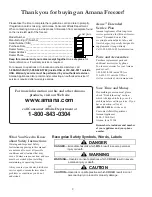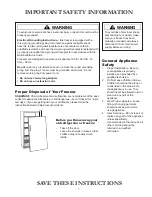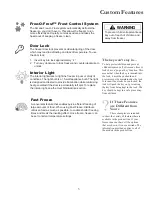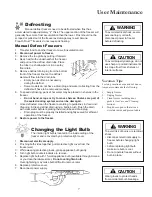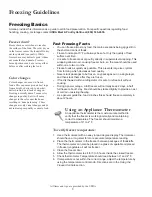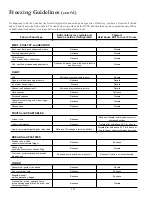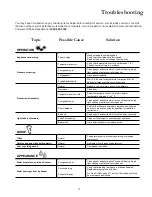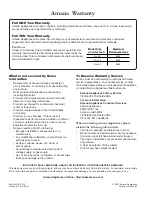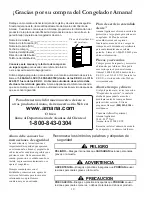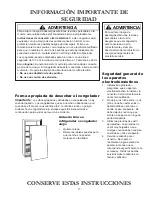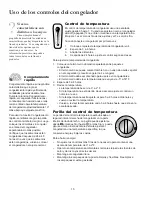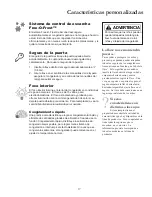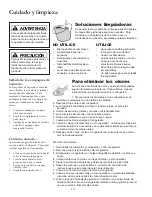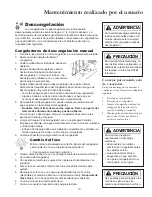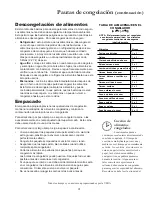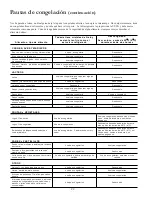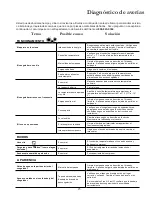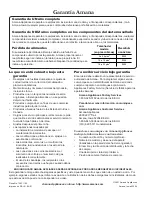
9
Freezing Guidelines
(contd)
FREEZER STORAGE CHART
(AT 0°F)
NOTE: Freezer storage is for quality only.
Frozen foods remain safe indefinitely.
Foodstuff
Months
Bacon and Sausage
1 to 2
Casseroles
1 to 2
Egg whites or egg substitutes
12
Gravy, meat or poultry
2 to 3
Ham, Hotdogs and Lunchmeats
1 to 2
Meat, uncooked roasts
9
Meat, uncooked steaks or chops
4 to 6
Meat, uncooked ground
3 to 4
Meat, cooked
2 to 3
Poultry, uncooked whole
12
Poultry, uncooked parts
9
Poultry, uncooked giblets
3 to 4
Poultry, cooked
3 to 4
Soups and Stews
2 to 3
Wild game, uncooked
8 to 12
Defrosting Foods
There are basic methods to defrost food safely. Food should never
be defrosted at room temperature. This allows deadly bacteria to
grow while the food is thawing. To defrost safely use:
•
Refrigerator: this allows the food to thaw in an environment
that controls bacterial growth. Food that is thawed in a
refrigerator can be safely refrozen without having to be cooked.
Most foods require a day or two to defrost, approximately one
day for each 5 lbs. of weight.
•
Cold water: place food in a leakproof bag and immerse it in
cold water (If bag leaks, food will become contaminated by
bacteria). Check water frequently to verify it stays cold. Change
water every thirty minutes. After thawing, refrigerate the food
until it is ready to use.
•
Microwave: cook food immediately after using a microwave to
defrost food. Microwave defrosting warms food and can partially
cook it, allowing bacteria to grow as it defrosts. Food cannot be
refrozen until it is cooked.
Packaging
Proper packaging prevents freezer burn, maintains quality of frozen
foods and minimizes odor contamination in the freezer.
For short term storage, it is safe to freeze meat or poultry directly in
supermarket wrapping. This meat should be used within 1 to 2 months.
For long term storage, follow these wrapping guidelines:
•
Overwrap store wrapped packages with airtight heavy duty foil,
plastic wrap or freezer paper.
•
Freeze unopened vacuum wrapped packages as they are.
•
Make sure lids are sealed tightly when using airtight freezer
containers.
•
Break down foods into smaller portions for faster freezing.
•
Freezer bags can be used. Remove as much air as possible from
them before placing in the freezer.
•
If a package has accidentally been torn or damaged while in the
freezer, the food is still safe to eat. Just overwrap it or repackage it.
•
It is not necessary to rinse meat or poultry before freezing.
¸
Cooking Frozen
Foods
Foods can be cooked or
reheated directly from the frozen state.
The cooking time will multiply to
almost one and a half times it would
normally take. Remember when cooking
poultry or meat to remove paper
wrapping, giblet sacks, and any strings
that might burn during cooking. Some
meats, such as pre-stuffed whole birds,
must be cooked from the frozen state to
ensure food safety. Remember to read
the USDA label on the meat.
All times and tips are provided by the USDA


